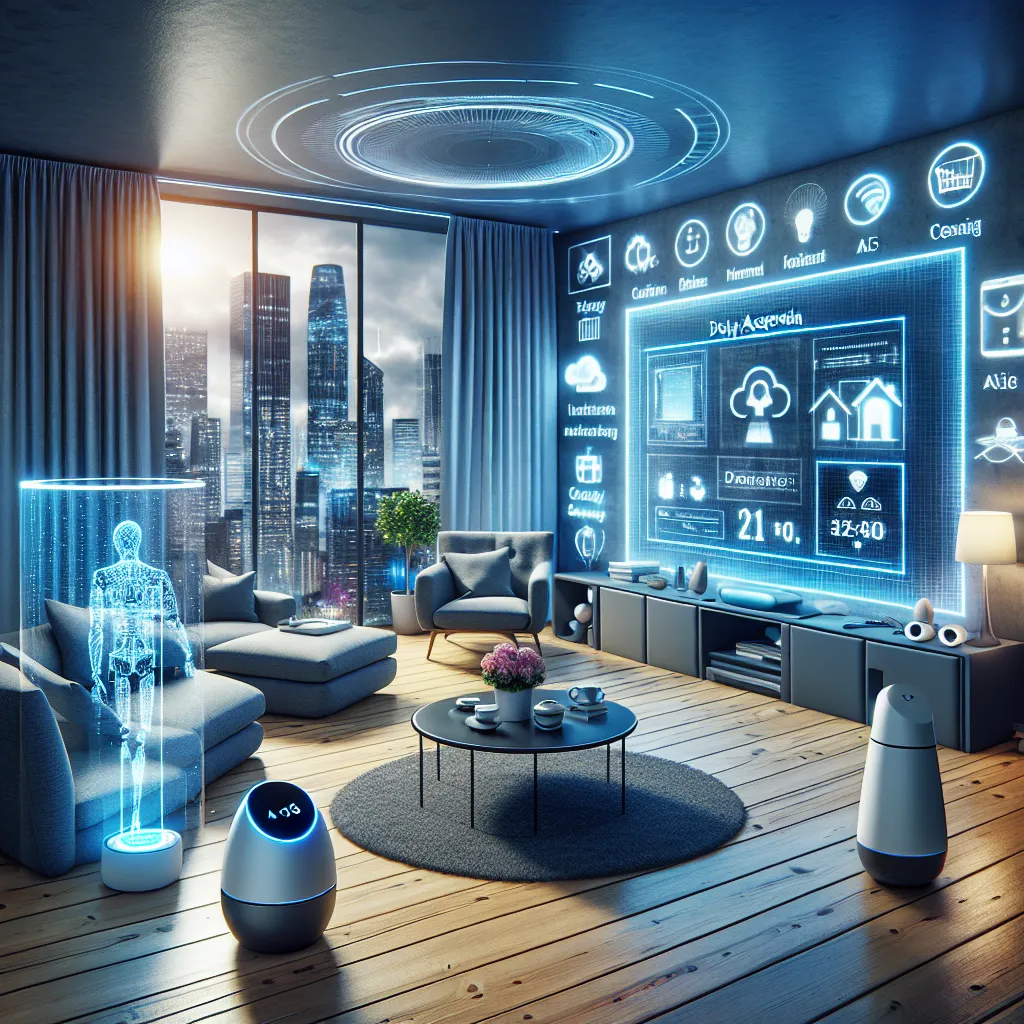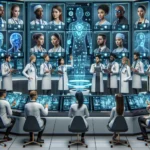Are you preparing for the IELTS Reading test and looking for high-quality practice materials? Look no further! In this article, we’ll explore the fascinating topic of artificial intelligence in our everyday lives through a comprehensive IELTS Reading practice test. As an experienced IELTS instructor, I’ve crafted this test to closely resemble the real exam, complete with passages of varying difficulty and a diverse range of question types. Let’s dive in and sharpen your reading skills while learning about the impact of AI on our daily routines!
 AI in daily life
AI in daily life
IELTS Reading Practice Test: The Role of Artificial Intelligence in Daily Life
Passage 1 – Easy Text
Artificial Intelligence (AI) has become an integral part of our daily lives, often without us even realizing it. From the moment we wake up to the time we go to bed, AI is working behind the scenes to make our lives easier and more efficient. One of the most common applications of AI in our daily routines is in smart home devices. Voice-activated assistants like Amazon’s Alexa or Google Home use natural language processing to understand and respond to our commands, helping us control our home’s lighting, temperature, and security systems with simple voice instructions.
In the realm of personal productivity, AI-powered email filters and spam detection systems help us manage our inboxes more effectively. These intelligent algorithms learn from our behavior and preferences to prioritize important messages and filter out unwanted spam, saving us valuable time and reducing email-related stress.
AI has also revolutionized the way we consume entertainment and media. Streaming platforms like Netflix and Spotify use sophisticated AI algorithms to analyze our viewing and listening habits, providing personalized recommendations that keep us engaged and discovering new content we might enjoy. This level of personalization has transformed the entertainment industry, allowing for a more tailored and satisfying user experience.
In the field of healthcare, AI is making significant strides in improving patient care and diagnosis. Machine learning algorithms can analyze medical images with incredible accuracy, often detecting abnormalities that might be missed by human eyes. This technology is particularly useful in early cancer detection and has the potential to save countless lives through early intervention.
As we navigate our cities, AI is quietly guiding our journey. GPS navigation systems use AI to analyze real-time traffic data and suggest the most efficient routes, helping us avoid congestion and reach our destinations faster. In some cities, AI is even being used to optimize traffic light timing, reducing overall traffic congestion and improving air quality.
The retail experience has also been transformed by AI. Online shopping platforms use AI to provide personalized product recommendations based on our browsing and purchase history. In physical stores, AI-powered inventory management systems ensure that popular items are always in stock, while dynamic pricing algorithms adjust prices in real-time based on demand and market conditions.
As AI continues to evolve and integrate into more aspects of our daily lives, it’s clear that this technology is no longer just a futuristic concept but a present reality that is shaping the way we live, work, and interact with the world around us.
Questions 1-7
Do the following statements agree with the information given in the passage?
Write:
TRUE if the statement agrees with the information
FALSE if the statement contradicts the information
NOT GIVEN if there is no information on this
- AI is only used in high-tech devices and not in everyday objects.
- Voice-activated assistants can control various aspects of smart homes.
- AI-powered email filters can learn from user behavior to improve their effectiveness.
- Netflix and Spotify use AI to create original content.
- AI has shown promise in early cancer detection through image analysis.
- GPS navigation systems use AI to predict future traffic patterns.
- AI is used in physical retail stores to manage inventory.
Questions 8-13
Complete the sentences below.
Choose NO MORE THAN TWO WORDS from the passage for each answer.
- AI-powered voice assistants use __ __ __ to understand human commands.
- Streaming platforms use AI to provide __ __ to users.
- In healthcare, AI algorithms can analyze __ __ to detect abnormalities.
- AI helps optimize __ __ __ in some cities to reduce congestion.
- Online shopping platforms use AI for personalized __ __.
- In retail, __ __ algorithms adjust prices based on demand and market conditions.
Passage 2 – Medium Text
The pervasive influence of Artificial Intelligence (AI) in our daily lives extends far beyond the realm of consumer convenience, profoundly impacting various professional sectors and reshaping the very nature of work. As AI technologies continue to advance at an unprecedented pace, they are augmenting human capabilities in ways that were once thought impossible, leading to increased productivity, efficiency, and innovation across industries.
In the field of finance, AI has become an indispensable tool for risk assessment and fraud detection. Machine learning algorithms analyze vast amounts of financial data in real-time, identifying patterns and anomalies that might indicate fraudulent activity or potential market risks. This capability not only protects consumers and businesses from financial crimes but also contributes to the overall stability of financial markets. Moreover, AI-powered robo-advisors are democratizing access to investment advice, providing personalized portfolio management services to a broader range of individuals at a fraction of the cost of traditional financial advisors.
The manufacturing sector has witnessed a significant transformation with the advent of AI-driven robotics and automation. Smart factories equipped with AI systems can optimize production processes, predict equipment failures before they occur, and adapt to changing market demands with remarkable agility. This level of automation not only increases productivity but also enhances workplace safety by relegating dangerous or repetitive tasks to machines. However, this shift also raises important questions about the future of employment and the need for workforce reskilling to adapt to an increasingly automated industrial landscape.
In the realm of education, AI is revolutionizing the way we learn and teach. Adaptive learning platforms use AI to tailor educational content to individual students’ needs, learning styles, and pace. These systems can identify knowledge gaps, suggest personalized learning paths, and provide real-time feedback, enabling a more efficient and engaging learning experience. Furthermore, AI-powered natural language processing is breaking down language barriers in education, making it possible for students to access educational resources from around the world through real-time translation services.
The transportation industry is on the cusp of a major revolution with the development of autonomous vehicles. AI algorithms are at the heart of self-driving car technology, processing vast amounts of sensory data to navigate complex road conditions safely. While fully autonomous vehicles are still in development, AI is already enhancing vehicle safety through features like adaptive cruise control, lane-keeping assistance, and collision avoidance systems. The potential impact of this technology extends beyond personal transportation, with the possibility of revolutionizing logistics and public transport systems.
In the field of environmental conservation, AI is proving to be a powerful ally in the fight against climate change and biodiversity loss. Satellite imagery analysis powered by AI can track deforestation, monitor wildlife populations, and predict natural disasters with increasing accuracy. AI models are also being used to optimize renewable energy systems, improve energy efficiency in buildings, and develop new materials for sustainable technologies.
As AI continues to evolve, it raises important ethical and societal questions that need to be addressed. Issues of privacy, data security, algorithmic bias, and the potential for job displacement are at the forefront of public discourse. Striking the right balance between technological advancement and ethical considerations will be crucial in shaping a future where AI truly serves the best interests of humanity.
The integration of AI into our daily lives and professional spheres is not just changing how we work and live; it’s reshaping our understanding of human potential and the nature of progress itself. As we stand on the brink of this new era, it’s clear that our ability to harness and direct the power of AI will play a pivotal role in addressing some of the most pressing challenges facing our world today.
Questions 14-20
Choose the correct letter, A, B, C, or D.
-
According to the passage, AI in finance:
A) Replaces human financial advisors entirely
B) Only benefits large corporations
C) Helps detect fraudulent activities
D) Increases market volatility -
The impact of AI on manufacturing includes:
A) Completely eliminating the need for human workers
B) Increasing workplace accidents
C) Optimizing production processes
D) Reducing product quality -
In education, AI is used to:
A) Replace human teachers
B) Provide personalized learning experiences
C) Limit access to educational resources
D) Increase the cost of education -
The development of autonomous vehicles is primarily aimed at:
A) Eliminating public transportation
B) Increasing road congestion
C) Enhancing road safety and efficiency
D) Reducing fuel consumption only -
AI’s role in environmental conservation includes:
A) Directly reducing carbon emissions
B) Replacing traditional conservation methods
C) Analyzing satellite imagery for various purposes
D) Slowing down the development of renewable energy -
The passage suggests that the ethical considerations of AI:
A) Are not important compared to its benefits
B) Have been fully resolved
C) Only concern privacy issues
D) Need to be addressed alongside technological advancements -
The overall tone of the passage regarding AI’s impact is:
A) Highly critical
B) Cautiously optimistic
C) Entirely negative
D) Indifferent
Questions 21-26
Complete the summary below.
Choose NO MORE THAN TWO WORDS from the passage for each answer.
Artificial Intelligence is transforming various sectors of society. In finance, AI assists in 21) __ __ and fraud detection, while also providing investment advice through 22) __. The manufacturing industry benefits from AI-driven 23) __ and automation, increasing productivity and safety. In education, 24) __ __ __ use AI to personalize learning experiences. The transportation sector is developing 25) __ __, which could revolutionize personal and public transport. AI also aids in environmental conservation through 26) __ __ __, helping to monitor deforestation and wildlife.
Passage 3 – Hard Text
The inexorable march of Artificial Intelligence (AI) into the fabric of our daily lives has ushered in an era of unprecedented technological symbiosis, fundamentally altering the human experience in ways both overt and subtle. This profound integration of AI systems into our quotidian existence raises complex questions about the nature of human agency, cognition, and the very essence of what it means to be human in an increasingly automated world.
At the nexus of human-AI interaction lies a paradoxical relationship: as AI systems become more sophisticated in their ability to mimic and even surpass human cognitive processes, we find ourselves increasingly reliant on these artificial constructs to navigate the complexities of modern life. This dependency, while ostensibly enhancing our capabilities and efficiency, simultaneously challenges our traditional notions of skill acquisition, decision-making autonomy, and intellectual self-reliance.
The ubiquity of AI-driven recommendation systems, for instance, has revolutionized our consumption patterns across various domains, from cultural products to consumer goods. While these algorithms undeniably offer unprecedented personalization and convenience, they also engender a form of cognitive outsourcing that may attenuate our capacity for independent discovery and serendipitous encounters. The question arises: as we increasingly delegate our choices to AI systems, are we inadvertently narrowing our experiential horizons and reinforcing our existing preferences and biases?
In the realm of cognitive augmentation, AI technologies such as natural language processing and machine learning are blurring the boundaries between human and machine intelligence. Advanced language models can now generate human-like text, engage in complex problem-solving, and even exhibit creative capabilities that were once thought to be the exclusive domain of human cognition. This convergence of human and artificial intelligence raises profound epistemological questions about the nature of knowledge creation and the role of human intuition and creativity in an age where machines can simulate these quintessentially human traits.
The integration of AI into decision-making processes across various sectors, from healthcare to jurisprudence, presents a double-edged sword. While AI systems can process vast amounts of data to inform decisions with a level of comprehensiveness beyond human capability, the opacity of many AI algorithms – often referred to as the “black box” problem – poses significant challenges to transparency, accountability, and ethical governance. The potential for algorithmic bias to perpetuate or exacerbate existing societal inequalities underscores the need for rigorous ethical frameworks and human oversight in the deployment of AI systems in critical decision-making contexts.
Moreover, the increasing sophistication of AI in emulating human emotions and social interactions, as evidenced by the development of empathetic chatbots and social robots, raises complex questions about the nature of emotional intelligence and human relationships. As AI entities become more adept at providing emotional support and companionship, we must grapple with the psychological and societal implications of forming emotional attachments to non-sentient entities. This blurring of the lines between human and artificial emotional intelligence challenges our understanding of empathy, intimacy, and the fundamental nature of human connection.
The pervasive integration of AI into our cognitive processes and decision-making frameworks also necessitates a reevaluation of educational paradigms and the skills required for future workforce participation. As AI systems increasingly automate routine cognitive tasks, the premium on uniquely human skills such as critical thinking, creativity, and emotional intelligence is likely to increase. This shift demands a fundamental reimagining of educational curricula and pedagogical approaches to foster these distinctly human capacities alongside technological literacy.
The ethical implications of widespread AI adoption extend beyond issues of privacy and data security to encompass fundamental questions of human autonomy and dignity. The potential for AI systems to influence human behavior through nudge technologies and predictive analytics raises concerns about the preservation of free will and individual agency in an era of algorithmic governance. Striking a balance between the benefits of AI-driven optimization and the preservation of human autonomy presents one of the most pressing ethical challenges of our time.
As we navigate this new frontier of human-AI coexistence, it becomes imperative to foster a nuanced understanding of the transformative potential of AI while remaining cognizant of its limitations and potential pitfalls. The path forward requires not only technological innovation but also a concurrent evolution in our ethical frameworks, regulatory mechanisms, and societal values to ensure that the integration of AI into our daily lives serves to enhance, rather than diminish, the human experience.
In conclusion, the role of AI in daily life represents a paradigm shift of unprecedented magnitude, offering immense possibilities for human augmentation and societal advancement while simultaneously presenting complex challenges to our notions of identity, agency, and the human condition. As we stand at this crucial juncture, our ability to navigate these challenges with wisdom, foresight, and a commitment to human values will determine the shape of our collective future in an AI-integrated world.
Questions 27-32
Choose the correct letter, A, B, C, or D.
-
The passage suggests that the relationship between humans and AI is:
A) Entirely beneficial
B) Completely detrimental
C) Complex and paradoxical
D) Easily understood -
According to the text, AI-driven recommendation systems:
A) Always lead to new discoveries
B) May limit our exposure to diverse experiences
C) Have no impact on our decision-making
D) Completely replace human choice -
The “black box” problem in AI refers to:
A) The physical appearance of AI systems
B) The lack of transparency in AI algorithms
C) The storage of AI data
D) The color of AI devices -
The development of empathetic chatbots and social robots:
A) Has solved all issues related to human emotions
B) Is considered unimportant in the text
C) Raises questions about the nature of human relationships
D) Is presented as entirely negative -
The passage suggests that future education should focus on:
A) Only teaching about AI technologies
B) Ignoring human skills in favor of technical skills
C) Balancing human skills with technological literacy
D) Completely replacing human teachers with AI -
The ethical implications of AI adoption discussed in the passage include:
A) Only data security concerns
B) Questions about human autonomy and free will
C) The complete elimination of privacy
D) The end of human decision-making
Questions 33-40
Complete the summary below.
Choose NO MORE THAN THREE WORDS from the passage for each answer.
The integration of AI into daily life has created a(n) 33) __ relationship between humans and technology. While AI enhances our capabilities, it also challenges our notions of 34) __ and intellectual self-reliance. AI-driven recommendation systems offer personalization but may lead to a form of 35) __ __. In cognitive augmentation, AI is blurring the lines between human and machine intelligence, raising questions about 36) __ __. The use of AI in decision-making processes presents challenges related to the 37) __ __ problem, which affects transparency and accountability. The development of AI capable of 38) __ __ __ raises complex questions about human relationships. The widespread adoption of AI necessitates a reevaluation of 39) __ __ to prepare for future workforce needs. Ethical concerns extend to the use of 40) __ __ and predictive analytics, which may influence human behavior and challenge notions of free will.
Answer Key
Passage 1
1


